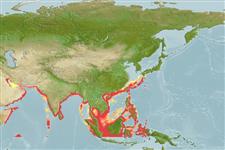分类 / Names
俗名 | 同种异名 | Catalog of Fishes(属, 种) | ITIS | CoL | WoRMS | Cloffa
Environment: milieu / climate zone / depth range / distribution range
生态学
海洋; 半咸淡水 居于水底的; 深度上下限 9 - 125 m (Ref. 9895). ; 32°N - 5°S, 47°E - 134°E
Indo-West Pacific: Persian Gulf to Sri Lanka and Indonesia, north to southern Japan. Reported occurrence of this species from Niue (Ref. 3804) should be verified.
Length at first maturity / 大小 / 重量 / 年龄
Maturity: Lm 20.1 range ? - ? cm
Max length : 40.0 cm TL 雄鱼/尚未辨别雌雄; (Ref. 11441); common length : 30.0 cm TL 雄鱼/尚未辨别雌雄; (Ref. 3391)
背棘 (总数): 0; 背的软条 (总数): 116-130; 臀棘 0; 臀鳍软条: 85 - 98; 脊椎骨: 50 - 57. Eyed side uniform brown, with a dark patch on gill cover, blind side white. Body elongate, its depth 20 to 26% SL. Eyes with a small scaly interorbital space. Snout obtusely pointed. Rostral hook short. Corner of mouth reaching posteriorly to or beyond lower of eye, about midway between gill opening and tip of snout. Caudal-fin rays usually 10. Midlateral-line scales 56 to 70. Scales large, ctenoid on eyed side of body. Cycloid (smooth) on blind side. Scale rows between lateral lines on eyed side of body 7 to 9 (Ref 9895).
Inhabits muddy and sandy bottoms of the continental shelf down to 125 m. Enters estuaries and tidal rivers (Ref. 1479). Feeds predominantly on bottom-living invertebrates. Marketed mostly fresh and frozen; also dried-salted (Ref. 9895).
Life cycle and mating behavior
成熟度 | 繁殖 | 产卵场 | 卵 | 孕卵数 | 仔鱼
Masuda, H., K. Amaoka, C. Araga, T. Uyeno and T. Yoshino, 1984. The fishes of the Japanese Archipelago. Vol. 1. Tokai University Press, Tokyo, Japan. 437 p. (text). (Ref. 559)
人类利用
渔业: 商业性
更多信息
合作者照片Stamps, Coins Misc.声音神经毒速度泳型鳃区Otoliths脑重体重比眼睛色素
工具
特别资料
下载 XML
网络资源
Estimates based on models
Preferred temperature (Ref.
123201): 23.5 - 28.7, mean 27.7 °C (based on 550 cells).
Phylogenetic diversity index (Ref.
82804): PD
50 = 0.5000 [Uniqueness, from 0.5 = low to 2.0 = high].
Bayesian length-weight: a=0.00398 (0.00251 - 0.00631), b=3.07 (2.94 - 3.20), in cm total length, based on LWR estimates for this species & Genus-body shape (Ref.
93245).
营养阶层 (Ref.
69278): 3.5 ±0.1 se; based on diet studies.
回复力 (Ref.
120179): 中等的, 族群倍增时间最少 1.4 - 4.4年 (K=0.24-0.98; tm=2;).
Fishing Vulnerability (Ref.
59153): Moderate vulnerability (37 of 100).
Nutrients (Ref.
124155): Calcium = 149 [70, 257] mg/100g; Iron = 0.909 [0.427, 1.502] mg/100g; Protein = 18.1 [15.9, 20.2] %; Omega3 = 0.12 [0.05, 0.26] g/100g; Selenium = 63.3 [32.5, 122.6] μg/100g; VitaminA = 20.5 [7.8, 50.7] μg/100g; Zinc = 1.33 [0.94, 1.82] mg/100g (wet weight); based on
nutrient studies.
